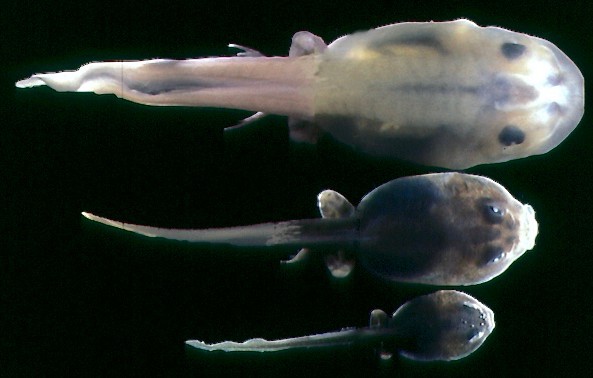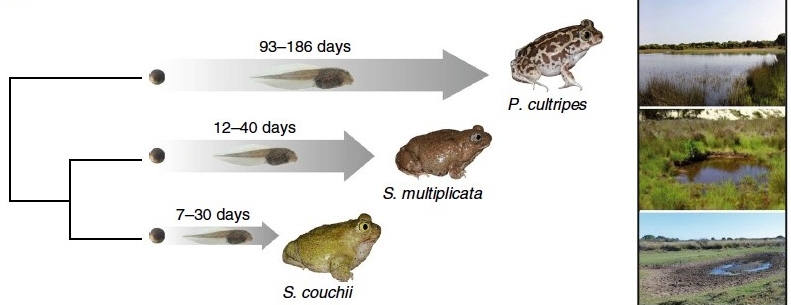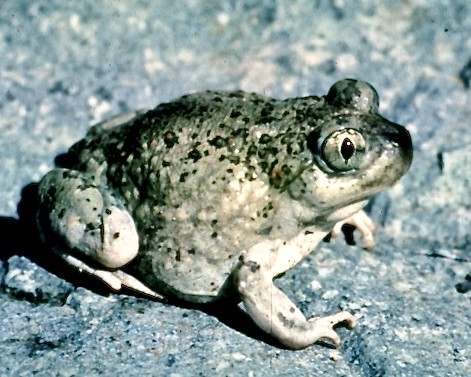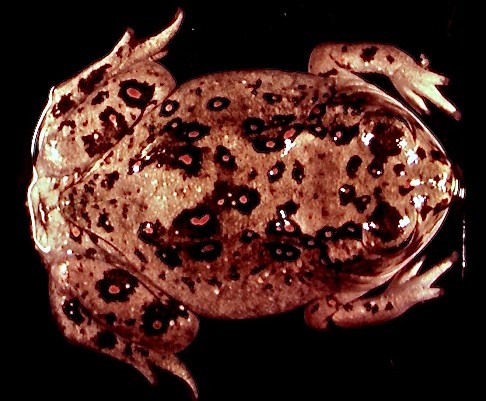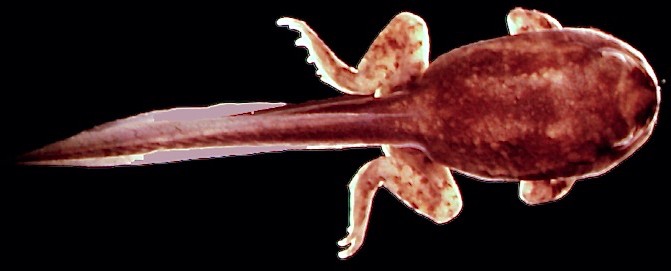Daniel Buchholz, UC biologist, illustrates the evolutionary size differences of three spadefoot toad species living in diverse climates around the world.
Toads get the jump on evolution
UC research links hormones and changing climate to altered evolution for spadefoot toad species.
By Melanie Schefft
513-556-5213
Photos provided
Oct. 25, 2017
Deep within aquatic ecosystems all over the world, certain toad species have managed to survive warmer and drier climate change. But the method behind their metamorphic adaptation to environmental change over time has long puzzled scientists –– until now.
NSF-funded research at the University of Cincinnati reveals how certain species of the pudgy spadefoot toads manage to ramp up their larval periods. They instinctively regulate their hormone production altering their developmental timetables –– all in an adaptive response to changes in their environment.
Daniel Buchholz, UC associate professor and biologist on the study, credits this survival process to a theory called “genetic accommodation” –– hereditary changes that occur in response to a changing environment.
“We found that when certain species combined stress hormones produced by the adrenal gland with hormones produced in the thyroid gland, this was key in speeding their development and shortening the larval periods. This process helps assure that they metamorphose or hatch before the pond dries up,” says Buchholz.
The study, recently published in Nature Communications, sheds light on how metamorphosis is controlled by hormone changes in certain species of spadefoot toads, supporting the theory of genetic modification by way of “phenotypic plasticity” or a change in physical characteristics of any plant, animal or microbe as a reaction to changes in their environment over time.
Life finds a way
To illustrate this phenomenon, the researchers spanned the globe and collected three species within the spadefoot family. They compared the Pelobates cultripes from Doñana, Spain, to two different species from Arizona.
In controlled experiments in the laboratory at UC, Buchholz and Saurabh Kulkarni, UC biology graduate student at the time and first author on the publication, compared larval periods directly to each other without outside environmental impact.
They found that Spanish and American species indigenous to permanent and semipermanent pond conditions had more flexible control over their development and could activate their own metamorphosis when they perceived their pond drying up too soon.
On the other hand, the desert species Scaphiopus couchii from the dry American southwest had already developed shorter and shorter larval periods –– primarily in response to environment conditions that gradually became more ephemeral or short-lived over time. At this stage of evolution, the desert toads were unable to react to pond water level and their short larval periods were now fixed.
While many of a given species will die if introduced to a profound change in their environment, Buchholz argues, some of the more hearty and healthier of the species will eventually evolve to survive in a new environment in an evolution by natural selection. But Buchholz says the key issue with these desert species is, “How did that process occur exactly?”
“One of the effects from rapid larval development in the desert toads is they don’t have certain physical characteristics that their cousins in wetter environments have,” says Buchholz. “”For example, the desert spadefoot is smaller and doesn’t have the metatarsal tubercles to dig, and they don’t have their gonads differentiated at that point.
“So there are consequences for having this rapid metamorphosis.”
But genetic modifications over time enabled desert species not only to survive but also to thrive in this new previously inhospitable environment.
Spadefoot species studied are from diverse environments. Top Pelobates cultripes from a permanent pond in Doñana National Park, Spain; middle Spea multiplicata resides in semipermanent ponds in the American southwest and bottom Scaphiopus couchii, the smallest with the shortest larval period lives in short-lived ponds in Arizona. Photo courtesy of Daniel Buchholz, Nature Communications and Creative Commons
Which came first?
In the complex cycle of survival, the researchers pondered whether the genes changed first or did a phenotypic plasticity allow for the survival that subsequently enabled their genes to change to ultimately survive in desert pools?
The researchers say their evidence is the best so far for showing how species’ differences may come about directly as a consequence of evolution of phenotypic plasticity in a changing environment.
For example, other scientists have shown similar effects in experimental populations of insects or within species with various populations living in different environments. They can see changes in the phenotype because they have been living in different environments. But the researchers say this study is the clearest example where differences between species can be understood based on evolution from phenotypic plasticity.
“One of my basic questions has been, ‘Why do these animal as well as human species look different from each other?’” asks Buchholz.
“What we have found about a major unappreciated piece of the explanation is that species differences in physical characteristics may be initially caused by environmental sensitive hormone levels controlling development followed by genetic changes that set the physical shape or morphological difference.”
You are what your ancestors did
If hormones control development and those hormones are a responsive system to the environment, Buchholz says the environment can transmit an environmental signal by way of temperature, food, predators, stress and anything that can impact the animal enough to turn hormonal signals on that help it adapt to those environmental stressors.
Similarly, humans can achieve different body sizes and skin conditions depending on their diets, activity, stress and other environmental factors.
He says that differences between species can evolve through the changing of their ancestral physical characteristics –– explaining how some changes can become fixed through the process of genetic accommodation.
“We think the ancestors enabled desert survival because their physical characteristics were flexible and they were able to respond to a drying pool by freaking out and having a stress-induced increase in metamorphic rate,” says Buchholz. “This enabled them to shorten their larval periods from months and weeks to just days by switching on corticosterone stress hormones that act synergistically with thyroid hormones to accelerate the metamorphosis to speed the development.
“Eventually this ability becomes fixed as the desert species consistently encountered short duration ponds. This allowed the tadpoles to use newly developed lungs to escape the drying pond and move safely onto land.”
Young Spea multiplicata in the middle of metamorphosis.
Climate-driven changes
Buchholz contends that species living in permanent or semipermanent ponds can prompt their own metamorphosis when they sense that their pond is drying up too quickly.
Thyroid glands are critical in frog development, just as in humans, but the spadefoot toads also activate their adrenal glands. This produces a stress hormone that accelerates metamorphosis in species with naturally longer larval periods.
“Over time, the smaller desert toads that survived a natural selection process developed a more rapid metamorphosis but now lack the ability to change their rate of development back in response to new environmental changes,” says Buchholz. “Another strategy to survive desert ponds seen in other spadefoot species is to become carnivorous when tadpole numbers are high in order to take advantage of a highly nutritious food source, which helps increase their rate of growth and development."
This study characterized the differences in species’ growth and development in different pond drying conditions and clearly shows how evolution of phenotypic plasticity within species can explain the physical differences between species through the process of genetic accommodation, say the researchers.
“Questions remain around whether the mechanisms detailed in our paper can apply to species dealing with modern climate change which is happening at such a rapid pace?” adds Buchholz.
Researchers involved in the study are Saurabh Kulkarni and Daniel Buchholz in the University of Cincinnati department of biological sciences, Robert Denver, professor in the University of Michigan department of molecular, cellular and developmental biology and Ivan Gomez-Mestre at the Doñana Biological Station in Spain.
To look at the hormonal responses, UC’s Kulkarni went to Denver’s laboratory at the University of Michigan to measure the hormone levels of all three tadpole species.
- Genetic accommodation via modified endocrine signalling explains phenotypic divergence among spadefoot toad species, published in Nature Communications, October 2017.
Peer into the world of biological evolution and climate change. Apply to UC’s department of biological sciences as an undergrad or graduate Bearcat.


